Today’s customers want to connect with businesses across multiple channels, including live website chat, social media messaging, in-app SMS, voice calling, and video calling.
57% of customers from all generations prefer to engage companies through digital channels like live chat, text, social media, etc.[*]
Omnichannel communication helps call centers offer a more personalized customer experience while relieving some of the stress on live agents.[*]
Here, we outline the most popular voice and digital communication channels and cover trends in omnichannel communication. Then, we’ll help you choose which channels most benefit your contact center.
Most Common Contact Center Channels
Below are the key contact center channels that are shaping the customer service today.
- Voice
- Live Chat
- SMS/MMS Texting
- Social Media
- Video Chat
- Web Forms
- Virtual Assistant/IVR
- Chatbots
- Team Chat
- Digital Whiteboard
- Knowledge Base
- AI-Powered Agent Assist
Voice
Voice calling is the most traditional communication channel, and is still widely used by companies and customers in nearly every industry to express empathy and build rapport. Now, virtual voice calling tools like VoIP and PBX power voice calling, and come with advanced features like call routing, self-service IVR, and AI voicebots.
Usage statistics
Voice communication remains popular amongst people of all ages, with 59% of consumers saying voice calling is their preferred channel.[*]
Technology/tools used
Many tools help contact center agents deliver direct, informed, and effective service via voice. Most are included as business phone system features, within a UC platform, or as part of a CCaaS solution.
- Call recording: Enables agents to manually or automatically record their calls so that they can reference them later or use them to train new agents
- Auto dialers: Automatically dials numbers on a preset list, screens out answering machines to increase productivity for outbound call center agents
- Call pops: Integrate with the company CRM to display caller information such as purchase history and geographic location
Email is the original digital channel and remains an important part of business communication for Generation Z, Millennials, and Generation X. Email allows consumers to reach out or respond to brands in writing, creating an automatic written record available to both parties.
Usage statistics
People first began to use email in the 1970s and its usage remains widespread with 92% of U.S. citizens reporting using it as a communication form. It is estimated that by 2026, there will be 4.73 billion email users worldwide.[*]
Technology/tools used
Although CCaaS platforms have traditionally focused on voice features, many providers now include business email tools such as:
- Email routing: Admins can automatically, classify, prioritize, and route emails to the most appropriate agent based on predetermined rules and criteria (order status, subject matter, purchase history, etc.)
- Canned responses: Allows agents to respond to customer emails by providing pre-written, customizable answers to common customer queries that agents can copy-paste and edit as needed
- Outbound email campaigns: Create customer email lists, send bulk marketing emails, create and edit email templates, schedule outbound email delivery
Live Chat
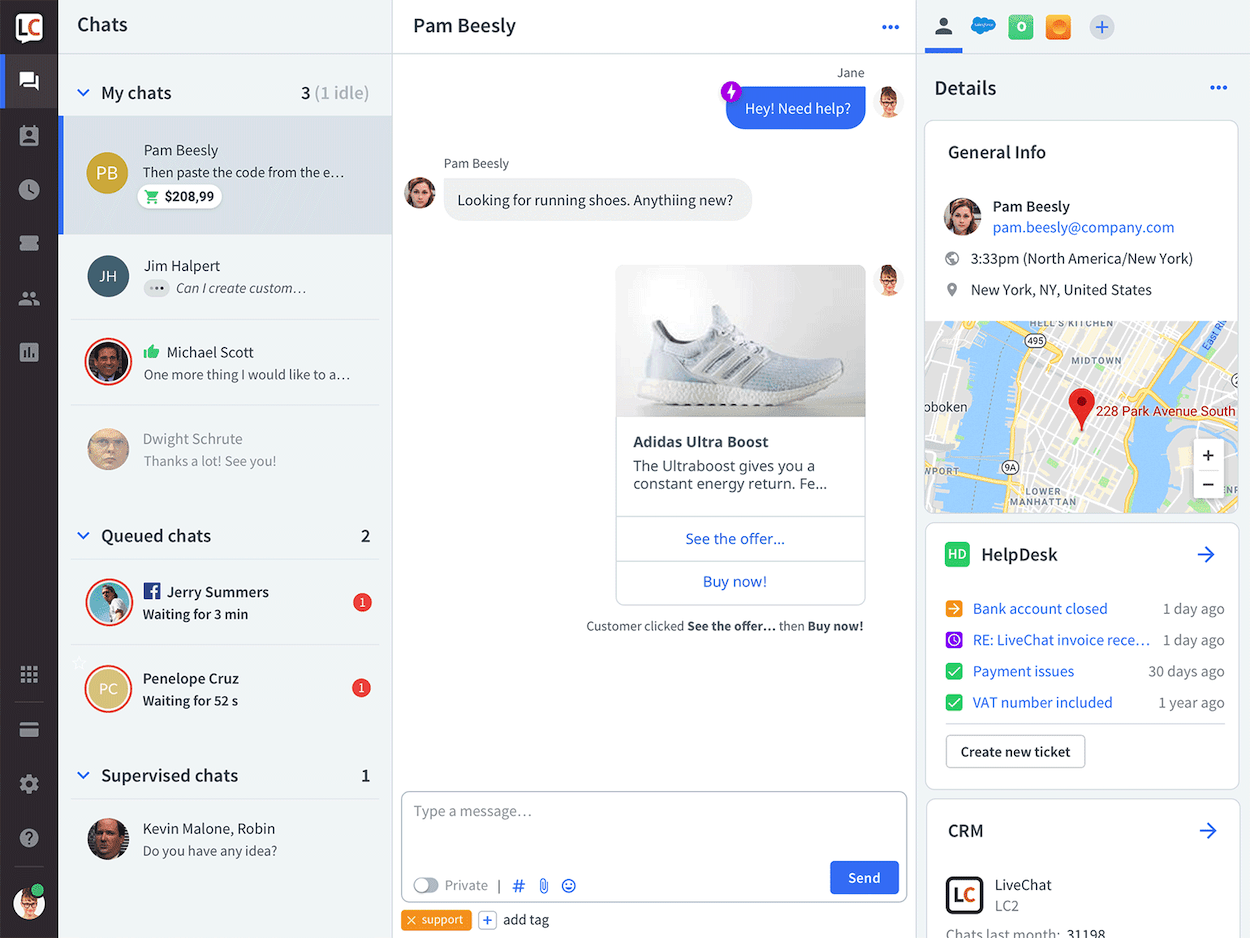
Live chat, or web chat, is a digital channel that lets customers chat with live agents in real-time, directly on the company website via a pop-up chat interface.
Usage statistics
Live chat is appealing to customers because it is text-based, has the immediacy of a phone conversation, and is generally available 24/7. 72% of consumers have reported that they prefer connecting with a brand via live chat as opposed to voice.[*]
Technology/tools used
Live chat platforms may include features such as:
- Preset messages: Automatically engage with website visitors via outbound proactive messaging
- AI assist: Generative AI tool assists live agents by checking each message for errors, adjusting tone, rephrasing, etc.
- Message sneak peak: Enables live chat agents to see what customers are typing before they hit “send”
SMS/MMS Texting
Texting has become so common in personal communication that it is sometimes jarring to receive a phone call. SMS, or short message service, refers to short text messages, while MMS, or multimedia messaging service, allows users to send images and files along with short-form text messages.
Usage statistics
Texting is very popular with consumers and Millennials and Generation X, as both rank SMS text messaging as their preferred communication method.[*]
Technology/tools used
There are several tools available to help businesses leverage text messaging in their contact center:
- Automation: Create trigger-based custom workflows to automatically send out SMS appointment reminders, follow-ups, notifications, promotions, etc.
- Opt-out options: Include an easy way for consumers to opt out of text messages to stay in compliance
- Multimedia attachments: Attach files, images, audio clips, and even video to text messages
Social Media

Social media platforms such as Facebook, Twitter, and Instagram are important to consider when implementing contact center channels. Many consumers, especially younger generations, spend a lot of time on social media and want to engage with brands on their preferred social media platform.
Usage statistics
Usage of social media for contact centers depends on the customer base and particular social media platform. According to one study, Facebook is the most popular platform for interacting with companies, with 60% of consumers stating that they use Facebook for customer service issues.[*] Instagram is next with 35% of consumers stating that they use Instagram for customer service. Other common social platforms are YouTube, TikTok, Twitter, Snapchat, and WhatsApp.[*]
Technology/tools used
Implementing social media channels can be a challenge, given many already exist and more are being created every minute. Know your customer base and what platforms they are using so that you can focus your efforts. Social media tools include:
- Insights and analytics: Allow companies to track metrics such as the number of messages, resolution time, first contact resolution rate, etc. across all social platforms under one pane of glass
- Social listening: Allows companies to track millions of conversations based around specified key topics using NLP and AI
- Social network integrations: Enable businesses to publish content, monitor topics, engage with customers, and access social media analytics directly from their CCaaS dashboard
Video Chat

Video conferencing is mainly known for its utility in team meetings and onboarding, but it can also be used as part of a multi-channel contact center solution Video chat is particularly helpful for customers who have issues where they need to show support agents something, like a damaged product or desktop screen interface.
Usage statistics
The use of video in communication is rapidly growing. According to one report, 78% of large businesses consider video an essential part of their communication strategy.[*] Video chat helps agents resolve issues faster and builds trust between agents and consumers, as customers can see the agent's body language and facial expressions.
Technology/tools used
There are a number of tools to make video chatting with customers easier including:
- Escalating: Allows the agent to move a conversation from any other channel to a video call when a visual is needed
- HIPAA compliance: HIPAA-compliant video chat solutions enable healthcare providers to offer telehealth appointments
- Video recording: Stored recordings enable supervisors to assess agent performance and create playlists for training purposes
Web Forms
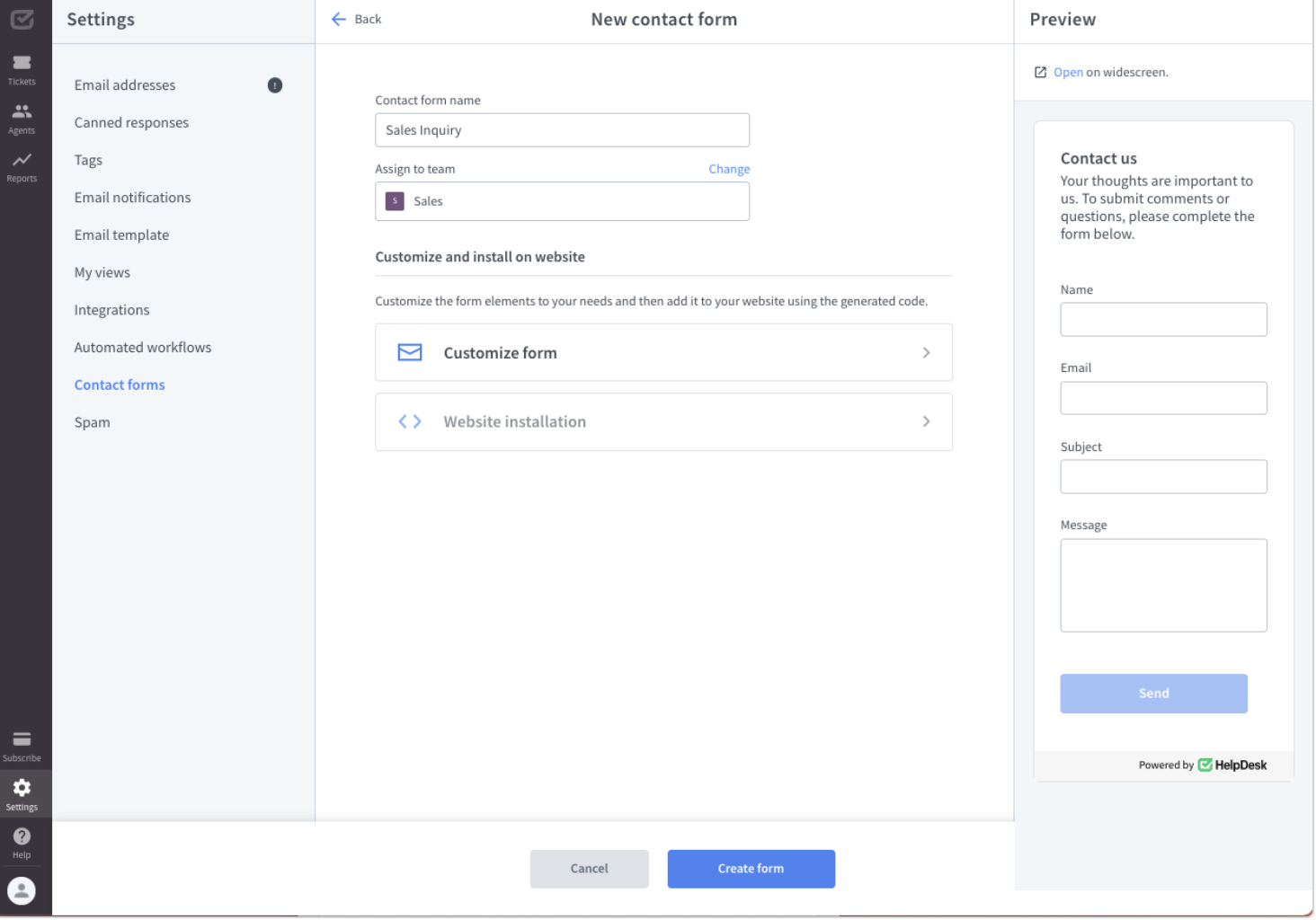
Web forms allow customers to fill out ticketing/support request forms on the company’s website. Businesses can customize web forms to collect essential and relevant customer data. Web forms can appear on a contact page or as a pop-up.
Usage statistics
Web forms can be used as part of a customer service strategy, with customers using forms to submit tickets, or as a way to generate leads. According to one study, 9.09% of individuals who encounter a contact form choose to submit it.[*]
Technology/tools used
There are several tools available to help admins create effective web forms for customers and prospects:
- Templates: Many providers include form templates such as contact, lead generation, order, registration, etc.
- Security features: Some providers include the option to add spam filtering, email address validation, and CAPTCHAs to forms
- Traffic analytics: Allows admins to track the web forms performance, organize submissions by time period, and see what part of the website the contact converted on
Virtual Assistant/IVR
An IVR system or Virtual Assistant is a customer self-service tool that provides automated call routing or basic support by letting customers interact with pre-recorded call flow menus. Based on their responses, customers are routed to a live agent, voicemail system, or another self-service tool.
Usage statistics
IVR systems were once a source of frustration for callers, but AI advancements have made them an essential contact center feature. Out of all the communication channels, IVR systems have the highest FCR (first call resolution) rate.
Technology/tools used
Many IVR features can help admins create a positive customer experience for callers:
- IVR payment: Some IVR systems integrate with payment gateway apps to allows customers to pay bills or fees over the phone without needing to speak to a live agent
- Skills-based routing: The system identifies the agents that have the skills to handle the caller’s needs and then automatically routes the call to the next available, qualified agent
- Speech recognition and natural language processing (NLP): The system will automatically pick up keywords that the caller says and route the call to an appropriate agent
Chatbots
Chatbots are another self-service tool, but instead of voice interactions, chatbots allow customers to interact by typing in an online messaging box similar to live chat. Chatbots are available 24/7 and do not require a live agent, but can be configured to escalate conversations to a live agent when necessary.
Usage statistics
Chatbots are mainly used to answer common questions or handle routine tasks to free up live agents for more complex issues. Chatbots are increasingly common, with 88% of consumers claiming to have had at least one conversation with a chatbot in 2022.[*]
Technology/tools used
Chatbot tools include:
- No code chatbot builder: Companies can build multiple bot responses and actions using drag-and-drop conversation blocks
- Testing: Most chatbot builders will include a testing feature that allows admins to test out how the chatbot will respond to prompts before it starts interacting with live customers
- Knowledge base integration: Enables chatbots to answer industry-specific questions immediately and accurately using the company knowledge base
Team Chat

Team chat is a platform or tool that enables employees to communicate with each other via instant message. Team members create group chats and threads based around specific topics or departments so that everyone stays on the same page. Colleagues can also attach files, send emojis, or invite outside contractors or clients to collaborate.
Usage statistics
Despite the shift to remote working, people still spend a lot of their time working with others, both in-person and virtually. One study found that during a typical work week, employees spend about 42% of their time working with others and only 35% working alone. The rest of their time is spent socializing and learning. [*]
Technology/tools used
Common team chat features include:
- Topic-based threads: Team members are only a part of group chats that concern them and conversations stay organized
- Notifications/Alerts: Employees set up custom notifications to be alerted whenever there’s a new message, a new thread, or they are @mentioned
- Generative AI: GenAI tools help rewrite and edit team chat messages so that everyone gets their point across
Digital Whiteboard
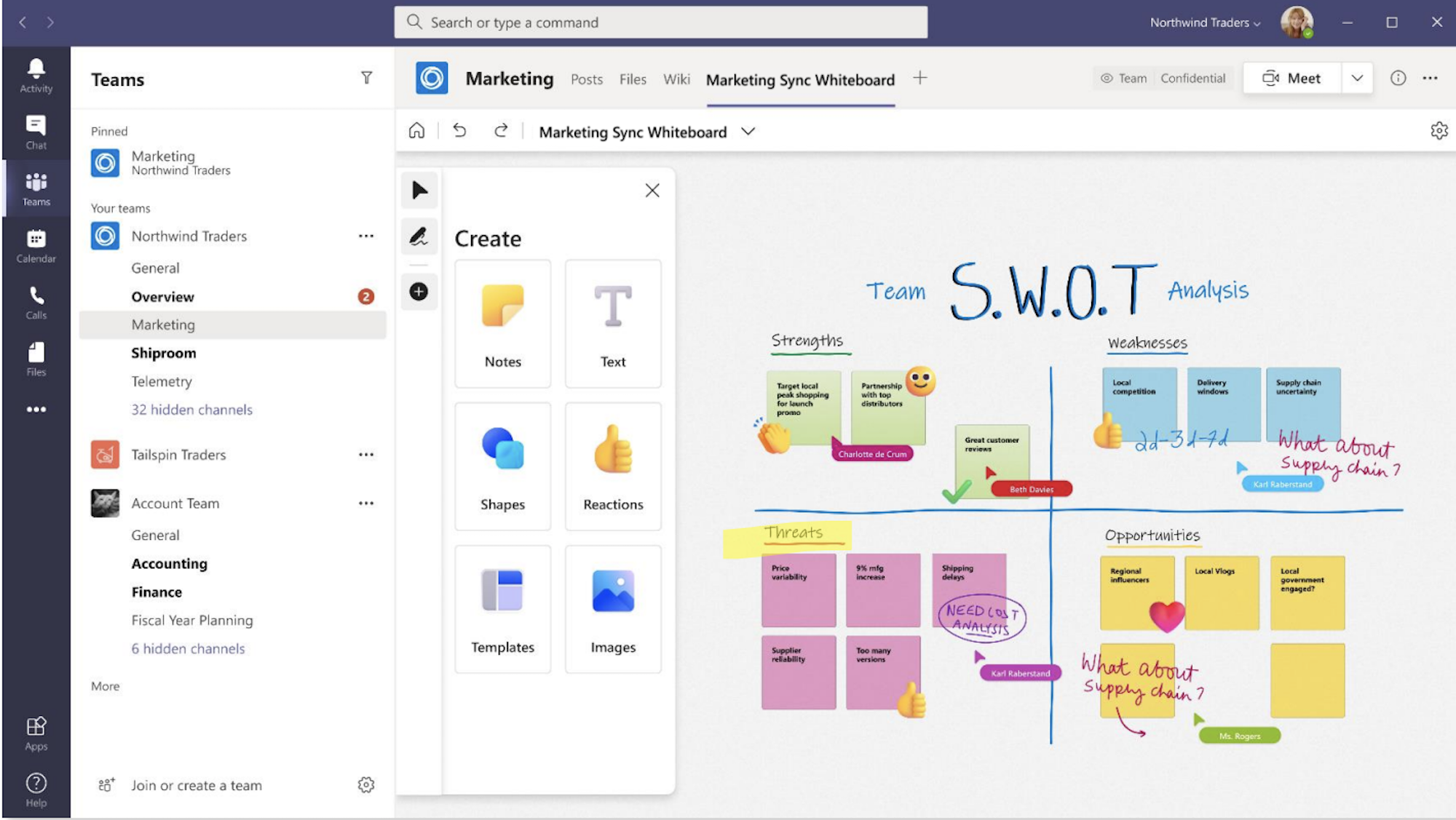
Virtual whiteboards are another tool used for team collaboration. Employees use whiteboards to brainstorm ideas, create interactive presentations, plan out events, and more. Employees are able to express themselves using drawing tools, sticky notes, attachments, etc in order to heighten creativity and problem solving skills.
Usage statistics
The whiteboard market has been growing, and is expected to reach a total of 7.6 billion by 2032.[*] Digital whiteboard technology is mostly used in academics and learning institutions (about 66%), with a large presence in the corporate sector as well.
Technology/tools used
Common whiteboard features include:
- Add links and videos: Some platforms allow team members to attach a website link or YouTube video directly onto the whiteboard
- Lock objects: This gives team members the option to create a sticky note or other object that cannot be edited by their colleagues
- Templates: Many providers include whiteboard templates such as “mind map” or “calendar”, so that employees don’t have to start from scratch
Knowledge Base
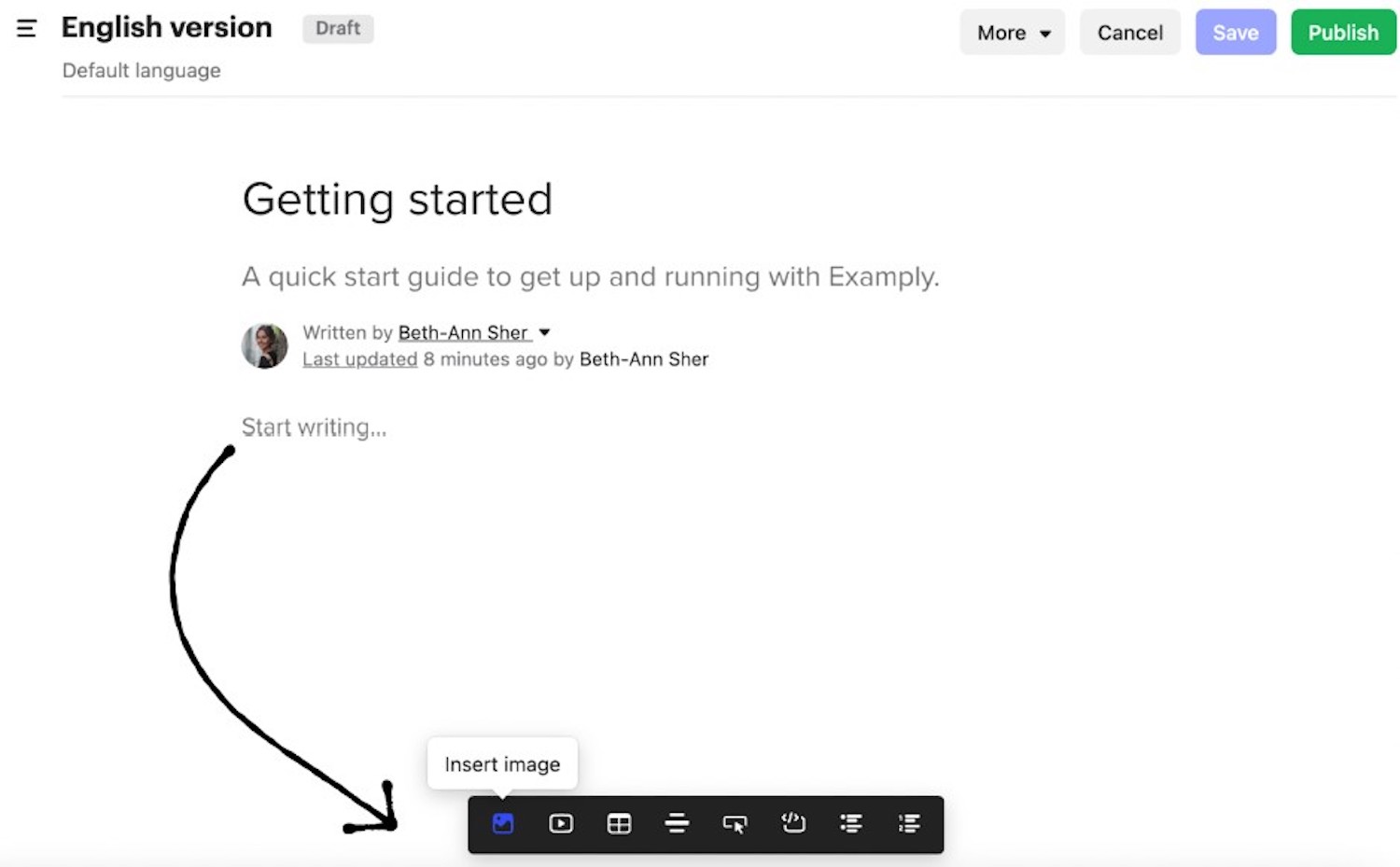
A knowledge base is an important part of brand-customer communication and is key for any self-service initiative. A knowledge base holds information about a company’s products and service, with problem solving tips, how-to videos, FAQs, etc. It provides a way for customers to get quick answers and resolutions 24/7/365 without having to contact customer service.
Usage statistics
Modern customers generally prefer to avoid contacting customer service and would rather use self-service first. One study found that 89% of millennials will use a search engine before contact customer service.[*] Having an up-to-date website with a navigable knowledge base is vital to meet customer expectations.
Technology/tools used
Some of the tools you might find in knowledge base software include
- Search function: A knowledge base is meant to be exhaustive so a good search button is necessary to help customers find what they need, quickly
- Analytics: Knowledge base analytics allow supervisors and admins see what customers searching for and whether a resolution was reached so that the knowledge base can be continually updated
- SEO: Search engine optimization tools help admins ensure that important information is easy to find when customers search for answers on websites like Google
AI-powered Agent Assist
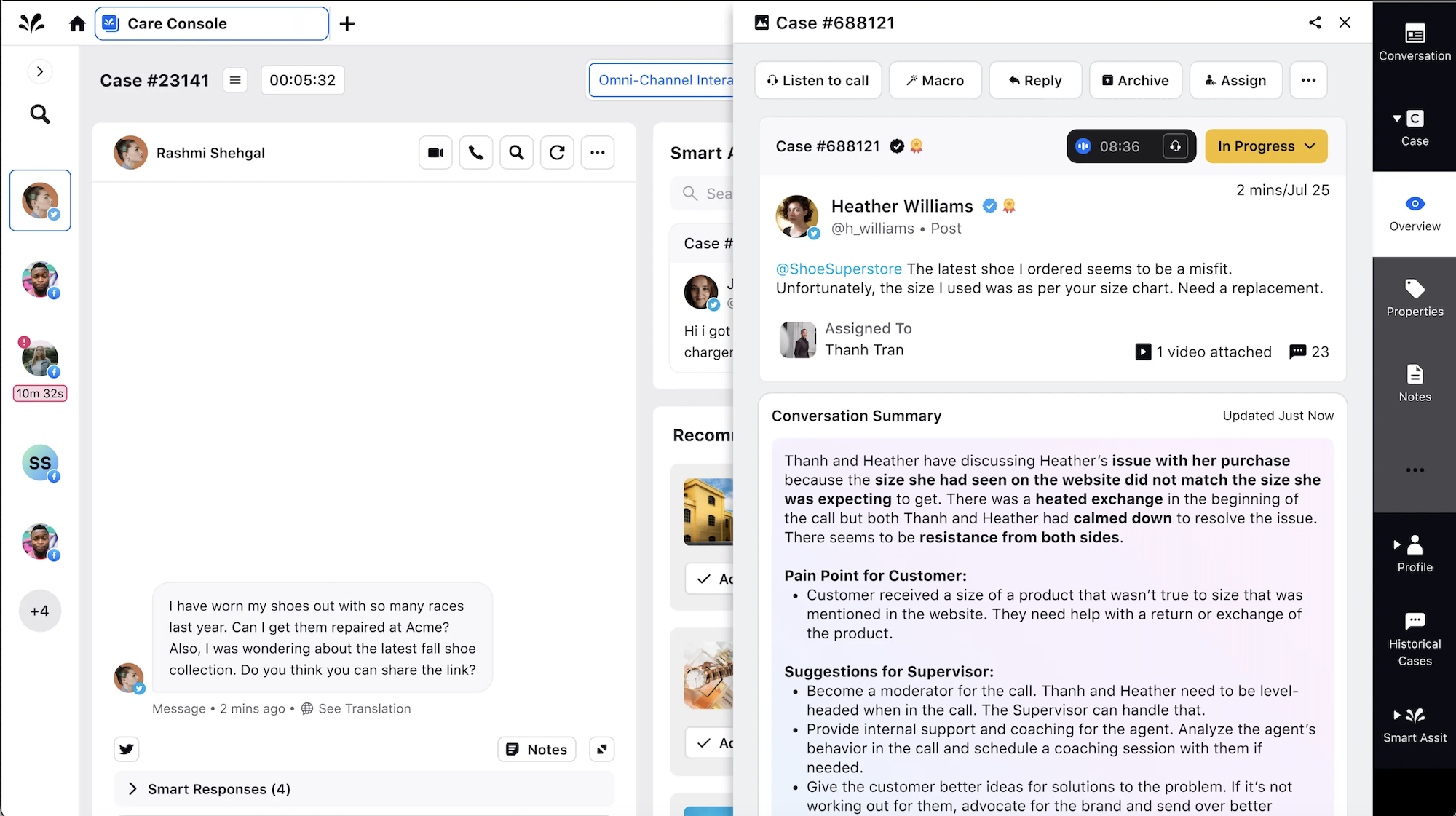
AI-powered Agent Assist is an advanced feature that provides agents with relevant information and assistance in real time. This information could include a customer’s purchase history while the agent is on a call with them, or information from the company’s knowledge base when the agent is answering a question. Agent assist can also perform a number of other functions, such as automating post call summaries, extracting action items, and letting agents know when they are talking too fast or out of compliance.
Usage statistics
AI Assist tools increase agent productivity drastically. One study found that employees using an AI assistance were able to process 13.8% more queries per hour than agents without an AI Assist tool.[*]
Technology/tools used
Here are some of the functions AI-powered Agent Assist can handle:
- Real time prompts: Provides agents with prompts to speak slower, ask for specific information, etc.
- Smart scripts: Displays a call script that automatically updates whenever the agent or customer says something
- Automated note taking and summaries: Automatically takes notes during the call, paying special attention to dates, keywords, and action items, and provides a post call summary
Video Overview of Popular Contact Center Channels
Growing Trends in Contact Center Communication Channels
The rise in popularity of digital communication channels has led to expansive research and development in the space, plus some exciting trends.
AI-powered Chatbots
Chatbots powered by Artificial Intelligence use Natural Language Processing (NLP) and machine learning to interpret customer needs. Once the question or issue is identified, an AI chatbot will be able to identify the next steps to provide the customer with a resolution.
AI Chatbots will continuously improve as they acquire more data. Becoming not only better at helping customers in general, but becoming more specialized and attuned to the needs of your customers specifically.
Intelligent IVR (IIVR)
Intelligent IVR, or Conversational AI, uses NLP and natural language generation (NLG) to enable customers to speak with a virtual assistant like a live agent. Instead of simply listening for keywords, IIVR uses sentiment and intent analysis to determine customer needs and respond accordingly.
IIVR has the potential to greatly improve the customer experience, decrease wait times, and relieve stress on live agents. However, these systems require extensive training and customization to be truly effective. Voice recordings of common questions and issues are helpful to train the IIVR system, especially if the recordings are in different languages and accents.
Customer Self-Service
With all of the improvements in conversational AI, other forms of customer self-service are growing in popularity. AI-powered bots can assist customers through a variety of processes such as registration, payment, appointment scheduling, etc.
Customer self-service not only helps businesses cut costs, but customers often prefer it, especially for routine tasks. For example, around 88% of customers have stated that they want a self service option available to them when shopping online.
Generative AI
Finally, generative AI is exploding in popularity in many sectors, and the contact center space is no exception. Generative AI can be integrated into CCaaS platforms to assist agents with live chat responses, emails, and social media messages. The powerful tools can also be trained with knowledge that is specific to the company, creating the most bespoke interactions.



